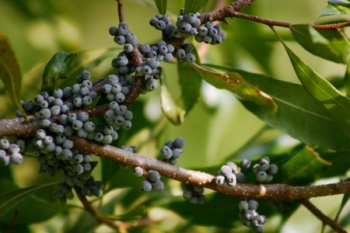Bayberry
Other Names : American Bayberry, Bayberry Wax Tree, Wax Myrtle, Yang-mei, Bayberry Bush, Arbe a Suif, Árbol de Cera, Arbre à Cire, Candleberry, Cirier de Pennsylvanie, Katphala, Morella caroliniensis, Morella cerifera, Morella pensylvanica, Myrica, Myrica caroliniensis, Myricae Cortex, Myrica cerifera, Myrica, Myrica heterophylla, Myrica pensylvanica, Myrica pumila, Tallow Shrub, Vegetable Tallow, Wachsgagl,...
Special Precautions of Bayberry
- Pregnancy and breast-feeding: Bayberry is considered POSSIBLY UNSAFE to take by mouth or apply to the skin if you are pregnant or breast-feeding because it contains a chemical that can cause cancer. Since Bayberry can stimulate uterine contractions, avoid during pregnancy.
- High blood pressure: Bayberry contains large amounts of chemicals called tannins. Tannins can increase the amount of sodium that the body retains. This can cause extra fluids to build up, and that can raise blood pressure. It’s especially important to avoid bayberry if you have high blood pressure.
- Water retention (edema): Bayberry might make edema worse. It’s especially important to avoid bayberry if you tend to retain water.
- When taken in high doses, Bayberry root bark can cause stomach distress, nausea, and vomiting.
- Those with chronic gastrointestinal conditions should use it cautiously.
- If you have kidney disease, high blood pressure, or congestive heart failure, consult your physician before using Bayberry.
- Safety in young is not known.
Health Benefits and uses of Bayberry
For hundreds of years, the Choctaw Indians used Bayberry. They boiled the leaves and drank the decoction as a treatment for fever. Later, Louisiana settlers drank Bayberry wax in hot water as a cure for dysentery. By the 19th century, herbalists recommended Bayberry bark tea for colds, flu, other infectious diseases, diarrhea, and fever. The herb's bark encloses a chemical compound called myricitrin, which is known to possess anti-fever attributes. Additionally, myricitrin together with the tannins present in the herb possesses anti-diarrheal qualities. While myricitrin acts as an antibiotic, tannins enclosed by bayberry work as astringents.
- treating common cold, coughs and flu : The dried bark in an infusion, can be used to treat colds, flu, fever, coughs, sore throats, and can also be used to treat excess vaginal discharge.
- The astringent property of bayberry is believed to cure intestinal problems, for instance irritable bowel syndrome (IBS) as well as mucous colitis (irritable bowel syndrome distinguished by the passage of abnormally great amounts of mucus). Then again, a paste made with the powdered bayberry root bark is applied topically on the ulcers and sores.
- an infusion prepared with the root bark of bayberry is also believed to facilitate in treating excessive vaginal discharge.
- Despite safety concerns, some people take bayberry for head colds, painful and swollen intestines (colitis), diarrhea, and nausea.
- prevent bacterial infections
- improving the blood circulation
- promoting perspiration
- helpful in constricting as well drying the mucous membranes.
- Taking a gargle with the herb is helpful in curing tender throats
- an infusion prepared with the root bark of bayberry is useful in making the spongy gums stronger.
- In large amounts, bayberry is used to cause vomiting.
